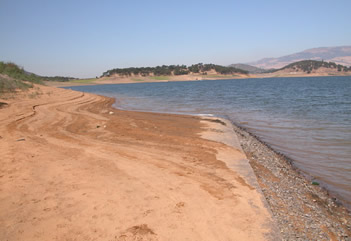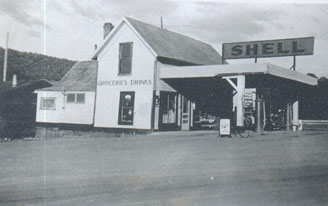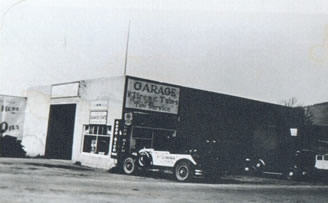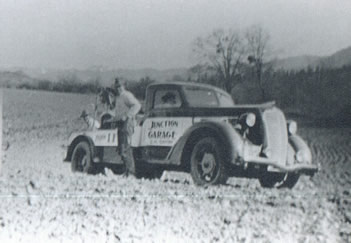It was a hot summer’s day as I sat in the shade of an apple tree inside the Hill Cemetery, overlooking a half-full Emigrant Lake, located a few miles East of Ashland, Oregon. With my back against the tree for support, I lifted my binoculars and could see where the Old Siskiyou Highway came down and disappeared into the lake. Off to my left I espied how the Old Greensprings Highway dropped and dipped into the waters in a similar fashion. Knowing that the road to Ashland used to pass through what is now an earthen dam constructed in the early 60’s, I could come quite close to triangulating the location of the now submerged Klamath Junction which, until the expansion of the lake, was the hub for travel to Ashland, Klamath Falls and the Siskiyou Summit.
Having recently read the 1951 typed history of the area as obtained both orally and through an old newspaper clipping by Juanita Howell Mayfield, along with her hand-drawn map of the structures that made up Klamath Junction, I set down my binoculars and closed my eyes. My mind slowly sank under the waters as I entered a world separated by both time and water, there to soak up the richness of our heritage as passed down from the original pioneers who saw the value of such a strategic and productive land. My thoughts swam like bass over, around, through the murky mix as those long-deceased beckoned, and lured me to share what were once their vibrant lives.
The first white women in the south end of the Bear Creek Valley were Elizabeth
Fine Hill and her daughters Martha, Mary and Ann. Headed up by father Issac
and brother Cicero, they settled on a Donation Land Claim which is now under
Emigrant Lake.
 |
 |
| James and Anne Russel's grave at Hill Cemetary | Old Siskiyou Highway dips into Emigrant Lake |
The Hills spent a year traveling from Tennessee, leaving with a covered wagon, considerable livestock, building tools, general supplies and two books: the Bible and Pilgrim’s Progress. Arriving in Ashland exactly 365 days later, with only a stove lashed to the back of a mule, they were greeted by a small one room, dirt-floored cabin, with holes for windows. The men had thrown the cabin together while the women spent several months at Fort Wagner, a fortified house in what is now Talent. Condos in Ashland are worth now a measure of gold, but safety from rifle shot or arrow blended values back then.
The women kept a brave face, but later revealed that they each wandered off to a secluded place and cried alone, such was their measure of pride and dedication... They had actually arrived in Oregon quite wealthy in livestock and possessions, yet a cruel winter and a path, instead of a wagon trail from the Willamette Valley left them broke, wagon less and on foot as they strode into the Valley.
The only problem with a Donation Land Claim is that the Rogue River Indians were there first. The Hill family soon became embroiled in a war with the Native Americans, who didn’t much appreciate the fact that 700 pioneers arrived the next year, each family to claim prime farming, hunting and living sites that the Indians had used for untold generations. The Indians slaughtered, while the pioneers merely massacred, the end result being a slew of dead and dying. Not too much to be proud about, all around.
[Humanity] has unquestionably one really effective weapon—laughter. Power, money, persuasion, supplication, persecution—these can lift at a colossal humbug—push it a little—weaken it a little, century by century; but only laughter can blow it to rags and atoms at a blast. Against the assault of laughter nothing can stand—Mark Twain
Much of the written history of the time concerns itself with births, death, fighting and misery. Surely some of the pioneers had an occasional good time, but there is hardly any mention of it. What we have reads as dry as the Southside of a northbound camel, the only moisture coming from tears of grief and the sweat of hard manual labor.
We have followed the Hudson Bay trappers as they followed Indian and animal
trails over the Siskiyous from California and, over time, how the path was widened
to a rutted, then a maintained toll road. This road lead to a now nearly forgotten
fork in the road called Klamath Junction.
The wagon/stagecoach toll road over the Siskiyous, used since the 1850s, gave
way in importance to the railroad when the Golden Spike was driven in Ashland
on the Dec. 17 1887, connecting Ashland to the balance of a nation-wide railroad
system. Railroad passenger traffic declined dramatically in 1926 as a faster
and more level route through Klamath Falls was opened. Ashland was kept viable
by an increasing flow of automotive traffic, fueled by Henry Ford's mass production,
which increased the pressure for more and better-maintained roads.
In 1926 the US Highway System was created and the former wagon/stagecoach trail,
as improved, became designated US-99, which reached Klamath Junction at the
bottom of the grade from the Siskiyou Summit. By 1948 much of the current route
of I-5 was adopted as Highway 99 and then upgraded to Interstate Standards in
1965.
It was during 1926 that Emigrant Lake was created, this to supply water for
the nascent systems of irrigation within the valley, one of which is known as
the Talent Irrigation District (TID). Vast expanses of fecund farmland brimmed
with peaches and pears, giving Harry and David a ready supply to fill its fruit
baskets destined for the nation’s markets. Some landowners were forced
to relocate, as the outline of the project became known. Back then there was
no way to appeal or question a federally approved undertaking and the only recourse
was to suck it up and move.
 |
 |
|
Shell Station
|
Caton's Garage
|
Klamath Junction slowly built up over the years. In the 1930’s it sported
a handful of houses, two gas stations, an automotive garage, café and
a roadhouse, the latter Called The Dutch Mill, which also held the dance hall.
The denizens were largely self-sufficient, heading down to Ashland infrequently
for special occasions or to get a fresh batch of books from the library. Surrounding
the Junction were abundant orchards planted by the pioneers, complete with a
packinghouse and an apple press. I can almost assure you that none of that apple
juice found its way through a fermentation and distillation process to become
the beverage of choice on Saturday nights at the Dance Hall. This was during
prohibition and we all know that good Americans didn’t drink then, don’t
we?
Well, something was going on, as each dance was accompanied by several fistfights
that were ceremoniously held up the road at a sulfur spring, where wounds were
tended and toasts made with untampered apple juice. The springs are now under
the lake, feeding the TID and the fish, as well as wetting the water-skiers
and increasing numbers of rowers who scull or sweep row their way in the early
morning calm. It is then that the lost voices can best be heard.
The lake was expanded in 1960, this accomplished by a much larger dam. Klamath
Junction was condemned to a watery grave, though the memories of the wagons,
stagecoaches and cars that traveled through live long in the memories of the
local families of the time. You could not drive from San Francisco to Portland
without passing Caton’s garage, which moved to Ashland next to Omar’s,
a famous steak and seafood restaurant, some 60 years ago.
The larger dam was to flood the pioneer cemetery, founded by the Hill Family.
An accurate burial census had to be compiled and permission obtained from the
descendents of the pioneers interred there. In 1958 workers dug up members of
the Hill, Dunn, Russell and other pioneer families dating back to the 1850’s
and relocated them to higher ground. The oldest known burial in the Hill-Dunn
cemetery was 19 year-old Isham Keith, nephew of Issac and Elizabeth Hill, who
was killed in 1853 on Evans Creek while fighting in the Rogue Indians Wars.
The war lasted 6 weeks and 17 pioneers rest now in the Hill Cemetery due to
that conflict.
In 1854 Ann married James H. Russell and Mary married Patrick Dunn. The following year Martha Married Almon Gillette. This being the final emotional blow to the dozens of Jacksonville miners who lined the fence around the Hill House every Sunday morning in hope of catching a glance of the only three young non-married women in the Valley. Mom was usually kind enough to invite the lot in for a meal, for which they donated items of rare availability, like a potato that cost a dollar. By the end of the meal the men got the message…those who brought the best gifts got larger portions, which is only my best guess.
There are people who strictly deprive themselves of each and every eatable, drinkable, and smokable which has in any way acquired a shady reputation. They pay this price for health. And health is all they get for it. How strange it is. It is like paying out your whole fortune for a cow that has gone dry---Mark Twain
Martha, in her later years, became an ardent Prohibitionist. She gathered some women who brought their rocking chairs and knitting needles to the Ashland Plaza, there to set up shop in front of the saloon. After 3 days with no one daring to cross this picket line, the saloon owner surrendered and moved his business to Medford. The shot was heard around the Valley. It now seems ironic that Ashland was forced to go dry, then Klamath Junction went all too wet. A glass of water between shots of whisky might have made a better compromise, though I think that Martha would have none of it. She seems to have read about Madame LaFarge knitting while the guillotine kept chopping away in Paris and liked the idea.
1865 the Russells set up a marble works along Ashland Creek…turning out monuments and headstones that were always in demand. A rock solid business in those days of often early demise. The fact that they owned the cemetery polished up their presence while keeping everyone humble. Between Ann and Martha the term “cold sober” took on a new and prosperous meaning.
Let us so live that when we come to die even the undertaker will be sorry. ---Mark Twain
 |
 |
| Climbing from the lake towards Siskiyou Pass |
Canton's wrecker
|
A couple of hours passed as I dreamed of the challenging lives of our pioneer
families while as I sat with my eyelids shut and my ears glued to the past.
Snapshots of a dirt floored hovel to greet the women who walked from Tennessee,
ogling gold-miners leaning on the fence, anxious for a fleeting glimpse of some
very young women, the screams, shouts and blasts of the Rogue Indian War punctuated
further snippets of wagons, stagecoaches, trains and model T’s made entrance
to Ashland from the south as the roads and rails got slowly upgraded.
I was suddenly awakened by the squawk of a crow which had landed atop the rounded
rock of the Russell’s grave. I must have startled it as it flew down over
the lake out and over Klamath Junction and beyond to the remains of the Old
Siskiyou Highway as the road began the ascent up the hill towards Pilot Rock,
which served as a visual clue to many thousands who came from California to
mark the pass over the Siskiyous into Oregon.
I found my heart beating in time with the flapping wings of the crow, my only
reminder that I am yet alive to honor the passing of the passing of some sturdy
folks, both native and non-native to our fertile valley and the lives we now
choose to live.